Deep into the darkness peering,
long I stood there, wondering, fearing,
Doubting, dreaming dreams no mortal ever dared to dream before.
-Edgar Allen Poe, The Raven
Gazing out into the dark abyss of the night sky, stars, galaxies, and clusters shine like tiny islands of light against the blackness of deep space. Trillions upon trillions of protons and neutrons fuse together in stars across the Universe, producing all of this light, and decorating the sky above.
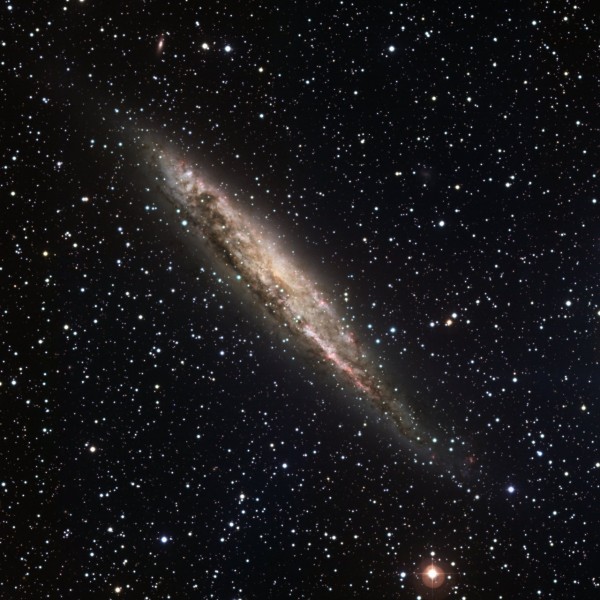
But, as we learned in part one of this series, the starlight that we see only accounts for 2% of all the matter that gravity tells us is there. What's more than that, is that we can figure out how much normal matter (i.e., stuff made up of protons, neutrons, and electrons, etc.) is around. We explored this in part 2, and found that this brings us up to maybe 15-20% of the total, but no more.
So, where do we go from here? Do we invent a new type of matter, and give it some bland, generic name like dark matter, or do we conclude that gravity is lying to us, because we've been using the wrong theory?
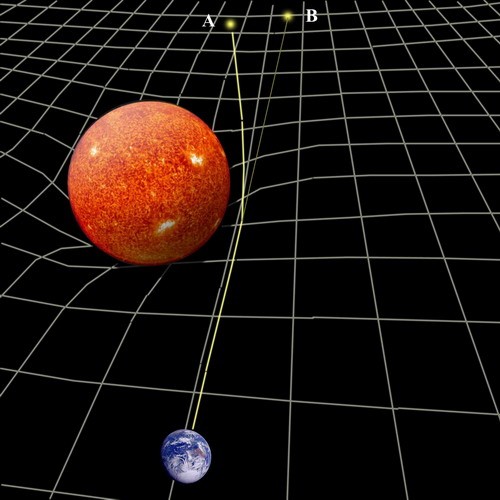
In principle, either one of these two explanations would suffice (although I'm hard-pressed to think of a third). If you're willing to add some new type of matter that doesn't behave the same way that normal matter does, you could explain all of the observations we discussed in the first two parts. But can you do this by modifying gravity?
I am telling you now, the answer appears to be no, as long as you demand that your new theory of gravity be sensible. Here's the three killer reasons why.
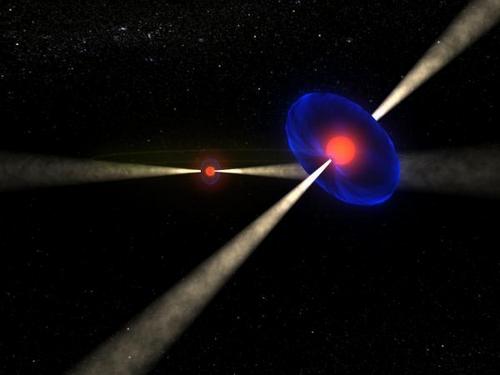
1.) General relativity works. In all the instances where Newton's theories failed observationally -- for the orbit of Mercury, for the bending of light by stars and galaxies, for pulsar timing variations and orbital decay, for the Lense-Thirring effect, and more -- Einstein's general theory of relativity saves us. If you're going to modify gravity, you'd better make sure your new theory can reproduce all of the successes of general relativity.
This immediately means that MOND (MOdified Newtonian Dynamics) is out as a replacement theory, as it fails to solve each and every one of the problems above. But maybe there's a way to do it. Maybe there's a way to modify Einstein's gravity (Bekenstein and Moffat have tried) to still keep all of the good stuff of general relativity and also to get rid of dark matter. But then this observation came along.

There are two clusters of galaxies here, interacting with each other. These galaxy clusters have just collided, clashing into one another. How do we know? The X-ray data shows us the evidence of a big SPLAT! that happened just a few million years ago:
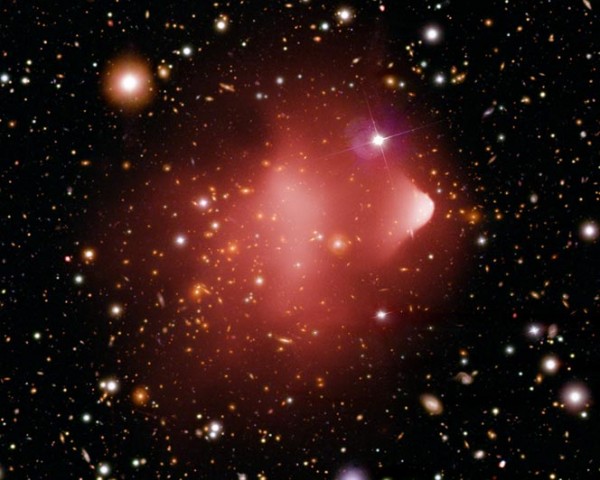
This splat tells us where the majority of the normal matter is: right in the center of the image. You can even see the cone-like shockwave on the right side. But what if we look for the evidence of gravity? We can look at the lensing data to tell us where the mass is.

And this is the key find. When you lay these images on top of one another, you find out, very clearly, that the majority of the mass is not where the majority of the gravity is. Which brings us to point number 2.
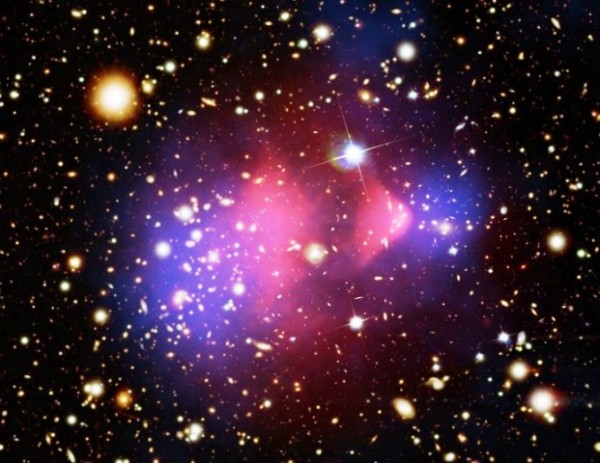
2.) Gravity does not always line up with where the normal matter lives. This tells us that either, again, we need dark matter, or we need to accept that not only is General Relativity wrong, but that gravity works in a very bizarre way. We'd have to modify gravity an additional way to make it non-local, or to make things gravitate towards places where there isn't any mass! This is very unsettling, but it's the only way to reconcile these observations without using dark matter.
And it can be done! In fact, Moffat (described above) made a version of this that works. Although it's extremely messy mathematically, he can get this "dumbbell" shape for gravity out of this configuration of mass without dark matter. Sure, it's non-local, but maybe that's not an impossibility.
There are, however, two interesting things that -- for me -- are convincing enough to kill this idea. Think about this, if you will: what did the bullet cluster look like before these two clusters collided? Wherever the normal matter (pink) was must have lined up precisely with where the gravity (blue) was. But after the collision, they don't anymore. Take a look at the animation below (use the control bar and double-click on the image to start/stop the animation):
3.) You either need a separate theory of gravity for each new geometry of cluster collisions, including for each cluster before and after the collision, or you need to add dark matter to your modified gravity anyway. So all you need to kill modified gravity? A second example of colliding galaxy clusters. If you'd need a second, incompatible theory of modified gravity to explain it, that tells you that modified gravity isn't the answer.
Well, say hello to the colliding cluster MACS J0025, in the optical:
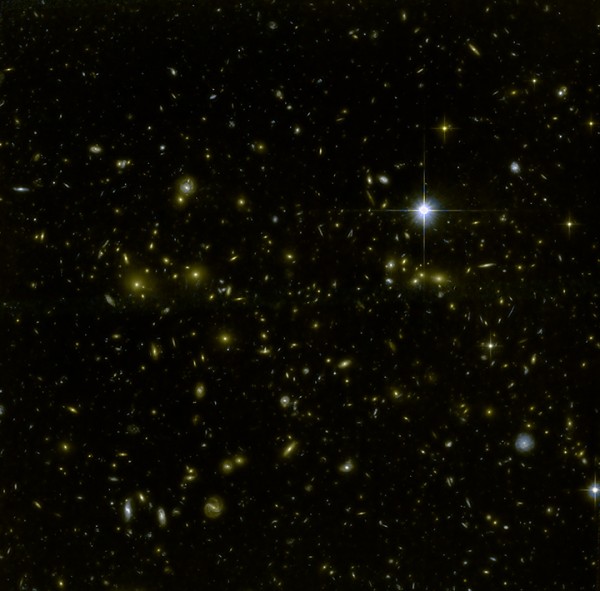
in the X-ray:

to the gravitational lensing data:

and to all of them combined.
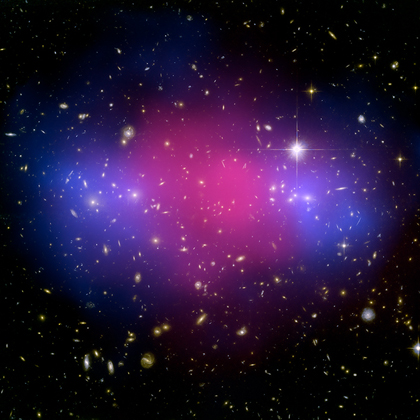
The configurations are incompatible. So either you need a different theory of non-local modified gravity for every colliding galaxy cluster in the Universe, or you need dark matter.
Not, mind you, that we know what dark matter is, just that we need it. When I write part IV, I'll go over some of the leading candidates, what I favor, and why. In the meantime, have you convinced yourselves that we need dark matter? If so, what was it that convinced you, and if not, where have you wriggled out of my reasoning?

I dislike the term "Dark Matter". It is like Holy Roman Empire.
1. It's not normal matter, so we would have to expand the definition. This may be ok if we are talking supersymmetry particles or axions or such.
2. It's NOT dark! It is transparent. "Clear Matter" or something might be better. The fact that the name is a bad description of one of the few things we can be sure of about it just bugs me.
3. It is totally confusing to many people with the similar term dark energy which have exactly two things in common - they are both about cosmological things and they are both terms in the universal gravitational balance equations.
Just getting irritations out.
I heard that ghosts are made of dark matter. I hope you address this important fact.
Could this be trying to tell us that the speed of light is not equal to the speed of gravity?
Actually "dark matter" and "dark energy" have 3 things in common. "dark energy" is also not dark.
I am unqualified to offer a calculated rebuttal, but I remain unconvinced none the less. My reasoning includes, but is not necessarily limited to:
1. We know GR is wrong; we can't quantize it and there are axioms of GR that conflict with axioms of the Standard Model, right? Personally, I find the error much more likely to be in GR than in SM.
2. I don't see why postulating 90% of the mass as ``dark'' is preferable to postulating corrections to gravity that would turn our current models on their heads. Just think about your post a while back: until Einstein suggested time and space were not absolute, it was absurd to think they were! (And you were asking what the next such paradigm-shift would be, and why don't we learn this lesson!) To claim non-locality or very complicated models that lead to different structure in different galaxies is far-fetched, seems no more worse than to claim 90% of the matter in the universe is something we don't know about yet. (And we're not even talking about the additional postulate of dark energy, which I find even more absurd; you side with the assumption that our gravity is right, but most of the mass and energy in the universe is unknown, rather than GR has some serious flaws, which most likely requires new measurements on new scales, which are very infeasible for us.)
3. (This is where my lack of qualification hurts most.) You present all this as if models of GR have been confined to some little box, that nearly all alternatives have been ruled out. I don't know definitively, but I suspect there are many alternatives we have not yet considered, maybe because of their bizarreness, maybe because we have not developed the required mathematical notation/insight/tools to comprehend them enough to even write them down! (Maxwell's original 20 EM equations come to mind, and the ease of the 4 vector equations that have replaced them.)
Theres more probably, but this post is too long already. Thank you for these excellent posts, and I apologize if I come across as rude, you've done an excellent job in summing up the state of things, (as well as explaining all sorts of other awesome cosmology and astronomy all over the place.)
Thanks again!
This article makes me think; does dark matter risk astrophysics running down the same type of horrible, stymieing cul-de-sac that chemistry went down with phlogiston for a hundred years in the 18th century? Phlogiston was created by George Stahl's innocent hypothesis of what could fill a role in chemical reactions (which turned out to be oxygen, and worked the reverse of what he thought, but wasn't isolated and tested until a century after his death), but his disciples started getting the word out, and trying to force phlogiston into any place it looked like it'd vaguely fit, while ignoring some massive problems with the theories.
Does dark matter risk doing this for astrophysics if people continue trying to use it in their theories and explanations of how the universe works?
Cody - I'm another unqualified source, but I'd like to ask a question.
In which circumstances has GR failed or been incorrect? I doubt this only because I haven't run across any examples in my reading. I'd like to explore them inasmuch as my understanding allows if you're willing to point me in the right direction.
Also, when you reference the apparent parallels between Einstein's seemingly absurd notion, it must be noted that Dr. Siegel has actually already addressed this. Relativity was seen as absurd until he showed that mathematically it was possible, and experimentally it was evidenced. The alternate theories all lack this characteristic of progressive science. So they are extremely dissimilar to Einstein's world-changing discovery.
And briefly, to your third point: there will never be a time when an enormous number of alternatives hasn't been considered. This argument undermines not only GR, but every scientific law, theory and discovery ever made. We don't arrive at knowledge by considering every innumerable option with equal weight. Unless we all want to read dissertations on the holes in "Cosmic Dreidel Variance in Gravitational Observations" or "Extra-dimensional Nanites as Quantum Obfuscators."
I lurrrve the Bullet Cluster (and cousins).
Rem acu tetitigisti. Mark of the crakpot. Gut-feeling, no sense or reason.
Marrk, you may not like the name, but it's there, get used to it. It's like Franklin's definitions for charges/currents - he guessed wrong, but very few people have changed the definition (I think some EEs have, though, hence the "few"). Fischer was lucky when he assigned L/D forms to sugar. "Dark" works, and it's easier to explain than change. "Matter" fits exactly because it clumps like matter.
Dark energy is enigmatic, but was named by association. Again, it can hardly be changed by fiat. On the other hand it's nothing but a placeholder for a phenomenon. If we determine that it's due to a cosmological constant, then we'll eventually start staying that. But for the time being it works to have a separate name, so that we do not get mired in a fixed idea about it's nature.
@Cody:
It's imprecise to say GR is "wrong" because it is not quantizable. It is an 'effective theory' in that it makes predictions which can be empirically tested and shown to be in agreement with reality. Any quantum gravity theory (or classical, for that matter- this is Ethan's point) must not make predictions which turn out to be false. Since GR is so well tested, it is expected that any GUT will reduce to GR in the limit that quantum effects become negligible, just as Newtonian theory is effective in the limit that gravity and speeds are small.
By your reasoning, even the SM is 'wrong', since there is no prediction of particle mass. However, it is the most 'right' theory known, given the precision to which things predictions match measurements. Ethan is arguing against modifications to GR on the basis that it matches measurements- any alternative theory must at the very least not be contradictory to things we already are certain about.
That said, I think you are right that not all modification theories have been explored here. I don't know if he's excluded distance-dependent modifications-Ethan?
Cody, Re your #2:
If I understand the post (which is questionable - me being a lowly biologist), dark matter can resolve all the discrepancies for all colliding clusters with a single new postulate. Modifying gravity requires a different new postulate to explain each different colliding cluster. If so, that seems like a perfectly good reason to prefer dark matter over modified gravity, all else equal.
I probably won't be back to read a reply, so this is just a general musing (found this article in passing). Feel free to email flak to me though...
I agree with Jesse Pino on most points, but my gut (un-scientifically) sides with Cody's opinion. If I were to hedge bets in my ignorance, I'd expect the "flaw" to be in GR, rather than requiring the assumptive necessity of, well, phlogiston. In this spirit, it seems to me from the overlaid images that the mass area shown by the x-rays would naturally be lensed by the blue gravity regions. 'Nother words, is the lensing data truly taking into account the correct measurements for x-ray radiation? Or are the centers of mass closely aligned with the centers of gravity, with the lensing effect funneling the radiation away from where it comes from? Also, does "dark matter" emit X-rays? How do we know? If not, then what's producing the x-rays? I was under the assumption that DM is "dark" (or clear) because we can't observe it directly (including emissions). Seems like X-rays would be a dead giveaway. Look for X-rays, find dark matter...
You forgot to mention this one:
http://arxiv.org/PS_cache/arxiv/pdf/0812/0812.1059v3.pdf
it'll probably be some new particle that couples to the gravitional field, but not the electromagnetic field. of course, i don't know the standard model and the mathematics of group theory well enough to know if i should be laughed at for that suggestion...
the neutrino took twelve years to be discovered after it was first suggested. it also took about 70 years to decide that neutrinos have mass. hopefully we won't have to wait another 70 years to figure out dark matter.
My understanding is that some string theories have time contracting (going slower) as the spatial axis expand. I know there was at least one paper suggesting that that effect could account for so called dark energy. Not clear to me if it could account for dark matter but I assume the time rate of change affects accelerations due to gravity as (delta t)^2. Perhaps your or one of readers have had the chance to think this thru.
also not an expert (IANAP) but my understanding is that the Standard Model is based on a lagrangian that is a linear combination of components. As long as DM doesn't couple to the SM particles (fermions & baryons), there's no reason the SM lagrangian couldn't be: L(sm) + L(dm). Both L parts would have some kind of coupling to gravity (the simplest being to replace the minkowski flat metric with g-mu-nu and allowing g to vary in relation to a stress-energy tensor that we don't know how to write down, producing equations we can't solve). In a low-curvature setting, the L components uncouple to first order in delta(g), and you get back the unchanged standard model.
"... or to make things gravitate towards places where there isn't any mass ..."
Doesn't that translate to "scientists discover antigravity?"
I don't know what I'm looking at. Was that dark matter once part of those galaxies? If it was, why didn't it move along with gravity as the galaxies collided?
What I'm getting lost in with dark matter is - why does it behave exactly like regular matter, aka forms galaxies, clusters etc and doesn't either diffuse evenly or clump into "really black holes"? Does the mysterious dark particle have momentum it can't shed preventing dark matter "solar" systems?
Pretty much. DM is 'dark' because it doesn't interact via the electromagnetic force. But that is the prime mover for friction, so DM doesn't really have a mechanism for slowing down.
But it does have mass and that's why it clumps through. And that in turn is why we identify it as 'matter'.
That at least is how I've understood it.
Why "Dark Matter"?
No great swaths of antimatter.
Dynamic Cosmos.
If Cosmos symmetric; to make
Entropy run in a direction
there has to be a sink
Just a thought
Thanks
a few points that might help clarify some things for people:
1. 80-95% of the normal baryonic matter in any galaxy cluster is NOT in the galaxies themselves. rather, it's in a diffuse cloud of gas IN BETWEEN the galaxies. this is what collides and shows up as pink - 80-95% of the matter we can see.
2. The gravitational lensing technique allows you to create a map of the mass density of whatever is doing the lensing. The blue stuff is this density map, which shows what the strength of gravity is doing all across the image. The two peaks of this map (i.e. the two areas with the most mass) are basically right on top of the centers of the two blue blobs.
Conclusion: 80-95% of the baryons in the cluster (the pink stuff) are creating VERY LITTLE of the actual gravity. Therefore, the gravity is coming from something that is NOT the baryons.
The X-ray data shows us the evidence of a big SPLAT! that happened just a few million years ago:
Just a few million? I'm having a hard time reconciling that statement with the distances involved in clusters of galaxies. For the animation, just what type of time frame are we looking at?
So... pre-collision the centres of visible matter and centres of gravity coincide. Post-collision the centre of visible matter remains in the middle while the centres of gravity continue on the galaxies' original paths.
Why does the dark matter pass through where the visible matter does not?
Doesn't this imply that dark matter has an inertial mass greater than gravitational mass?? Or, as Sili mentions at #18, is it really EM "friction" that retards the visible matter but not the dark matter? Both seem counterintuitive to me.
I forgot two things:
1/ What is the source of the galactic collision observations - who, when, where?
2/ The series on dark matter has been fantastic so far!
Okay, this question is hopelessly naive and idealistic. Bear in mind I'm an interested layman with no formal background.
So, dark matter has mass, but it doesn't radiate any detectable energy. Meanwhile, I keep hearing about the Higgs boson, which imparts mass to massless charged particles. Speculatively speaking, could the search for Dark Matter and the search for the Higgs boson be connected? Might the two problems have the same solution?
In both cases, there is mass we can't account for using current models. Could there be something at work that gives mass to both dark matter and the W and Z bosons? (And if so, would that give us the fabled Grand Unified Theory?)
where have you wriggled out of my reasoning?
At the part where x-rays = normal matter. why come? i get the lensing, this falls out of general relativity's description of how spacetime is bent by gravity. the amount of bend tells you the amount of gravity. straightforward math. but the confidence that the x-rays map to where the 'known' matter is - that one i don't share. please elucidate.
blueshifter:
this x-ray gas is a well-known phenomenon in galaxy clusters. see:
http://en.wikipedia.org/wiki/Intracluster_medium
Ethan: You seem awfully certain of your facts. For example, what leads you to believe that these galactic clusters are colliding and not (for example) calving, or simply orbiting in a plane more or less normal to us? The X radiation is supposed to be coming from the associated gaseous matter, but can there not also be associated gas that is not emitting X radiation? What fraction of the nearby gaseous matter that you know of radiates in the X band, vs. that which hardly radiates at all?
Sili: As I understand it, at cosmological scales, dynamical friction is a gravitational phenomenon. I don't know any reason why dark matter wouldn't participate as an equal partner in dynamical friction.
Nathan, I am awfully certain of my facts. Come back on Wednesday for an explanation of why.
Ethan, your series about dark matter is great -- concise, precise, and elucidating.
And to Markk, who says he/she dislikes the term "dark matter", because "It's NOT dark!", I respond: So called dark matter does not emit any photons, because of which we cannot see it, because of which it is rightly called "dark". Dark matter *is* dark.
The main problem I usually have with dark matter is the following, you claim that "the starlight that we see only accounts for 2% of all the matter that gravity tells us is there."
As I've always understood this, this amount of mass is calculated by looking at the absolute luminosity of a star, and using the mass-luminosity relationship (L = M^3.5, or possibly more refined models of this based on stellar evolution codes) deducing the mass of this star. Aside from possible observational errors in measuring the luminosity, the problem is: If you see a star of two solar luminosities, its impossible to decide whether you are looking at one 1.2 solar mass, or two 1 solar mass stars with a seperation distance smaller than the resolution of your telescope. So it's possible to make HUGE errors in calculations like this.
Combine this with the fact that stars may be obscured by, dust, other stars, etc... and that determining the absolute luminosity requires a measurement of the viewed luminosity and knowledge of the distance. So how certain are we that the stars we see really account for only 2% of the mass we detect? What are the error margins on this? (Many astronomers I know are satisfied by getting within one order of magnitude, might the 2% just as well be 20%?)
dg: thanks for the link, i did look up the relevant wiki entries beforehand, and you'll note that they don't answer the question "why we know this to be true". As i said in my original post, i DO understand why we know gravitational lensing to be true - it's a direct consequence of general relativity, and general relativity is a VERY well supported theory. For example, the article you pointed me to very confidently asserts that "the X-ray emission is proportional to the density of the ICM squared", but it does not give any supporting evidence for why this should be so. I am course, sure there is such supporting evidence, but I have yet to have it explained in such a way that i grok it. Perhaps this Bremsstrahlung radiation is a key to the whole thing, but when i read these articles on x-ray astronomy, i am struck by how many assumed inference leaps there are.
The sky is blue because the physical properties of the gases that compose the earth's atmosphere absorb other spectra more than blue. I get that. one line, simple. I'm looking for a similar "ah ha" explanation of why x-rays = normal matter. The wiki entries are circular, "it is cause i just said it is".
Not directly, but bear in mind that DM can transfer momentum to "normal" matter via gravitational coupling -- and the "normal" matter can in turn engage in lossy conversions.
The result is slow, so over the timescale since the Big Bang there will be a tendency of DM to "clump" with galaxies. However, when galaxies collide the DM keeps on going while a largish portion of the "normal" matter remains in the "middle."
Yes, oversimplified. It's been a long time since I did any physics remotely on this level -- but I still remember how to frame some things.
I remember two things from astronomy class in college:
1. Potassium flare stars turned out to be astronomers lighting matches when they went outside to smoke cigarettes.
2. Astronomers report data values where the errors are bigger than the values, such a 0.4 plus/minus 12.
But, seriously, how do you determine the size of the error when you measure galaxy mass by gravitational lensing?
Duncan, dark matter does not absorb (couple to) photons very well, so it is like very (very very very ...) clear glass. I have never heard anyone call glass dark... except when it was dark, i.e. not as transparent. That is, you can put a galaxy mass of dark matter in front of me and I can look right though it and not even notice it is there.
As I said this is one of the few things we know about dark matter - it has very low coupling to photons. It must be transparent not dark, so calling it dark is wrong. Now when Zwicky and such discovered the effects and before the results Ethan gave and people thought things like Massive Halo Objects (Machos) could be the dark matter, then the name made more sense, and we are stuck with it.
As someone else asked, gravity does follow the dark matter. The regular stuff got slowed down in the collision by friction (an electromagnetic phenomona in this case) but since the Dark Matter ... tada ... does not couple well with photons, the electromagnetic force carrier, it will just slide right though everything even better than neutrinos do, and only be affected by the gravity.
I would like to point out that GR fails to explain galaxy rotation, and inter-galactic motion, without the additional unproven postulate of specific distributions of exotic DM, (which last I heard were two different distributions). It also requires the unexplained cosmological constant to fit observed large scale expansion; you can't count galaxy motion+DM as confirmation of GR anymore than I can count galaxy motion w/out DM as falsification of GR, and so GR has not been validated in every observation to which it should apply.
Note, I'm okay with DM if it is all matter we know about (leptons, cold baryons, bosons), what bothers me is postulating something exotic that constitutes 90% of the universe's mass and yet has completely escaped direct observation. And another question, if GR is right, and exotic DM exists, why don't we detect it floating around in our solar system? At least just passing through, right? And since GR explains the solar system so accurately without DM, wouldn't that again mean GR needs modifying? (Symmetrical to Ethan's claim that no matter how we modify gravity, we would always need DM?)
Keep in mind, I'm not advocating that we abandon DM models, I'm advocating that we do not abandon the search for alternative gravity models. The proof will be in the cosmic pudding (or maybe the CERN pudding?). I just happen to suspect GR being the more likely error. (Though I reiterate: I'm not really qualified in these areas.)
Also, sorry to have caused such a ruckus. I'd like to spend time debating most of the points brought up against my previous post, but I don't really have the time right now, and this seems like an inappropriate venue for such debate. I eagerly await the next post in this series.
I'm not at all qualified to speculate on this, and I'm not even sure where this fits in with other theories like modified GR, or if some effect rules out these as possible explanations. I suppose that's why it's called "speculation"... but I always love to hear how wrong I am anyway, because then I learn.
As Olowkow asked in comment #3: Could this possibly be a consequence of there being a difference in the speed of light and the speed of gravitation?
Also, could it be that these diffuse intergalactic clouds of "normal" matter are so diffuse that they won't produce the expected amount of gravitational lensing? That is, could a diffuse body of matter like that basically have a flattening effect on space, because almost by definition it has no large, point-like centers that could noticeably bend the light the same way more dense areas would?
In other words, one particle bends a photon's path in one direction, then another bends it another, so that overall the random assortment of them mostly cancel out the effect you find in densely-packed objects like stars. I would guess the math has already been done, but I just have to wonder how much of a discrepancy there is between the expected amount of lensing and how precisely we can observe and predict it in the first place.
I confess, up front, that I am no astrophysicist (the lure of maths was too great), but I would be interested in some clarifications, if anyone would be so kind...
dg: could you elucidate where you get your figures that 80-95% of cluster baryonic material is contained in the intracluster medium?
In Binney's "Galactic Astronomy", p.532, he states "The mass of the intracluster medium is enormous - it exceeds the total mass in the luminous parts of the cluster galaxies by a factor of several". Quite vague, I think you'll agree, although I readily admit it supports you in principle.
This vagueness is repeated in Carroll's "Introduction to Modern Astrophysics", 2nd Ed., p.1066, when discussing the intracluster medium he states, "Typically the mass of the gas is several times greater than the combined mass of all stars in the cluster's galaxies". He does then go on, in p.1069, to make a rough calculation of this value for the Coma cluster - "According to this estimate, there is roughly 7 times more intracluster gas in the Coma cluster than there is in its galaxies' stars". That would accord with your lower value, but not the higher. And the error bars on his calculations would be VERY large.
dg: Anyhoo... your claim that the location of this intracluster medium is delineated by the x-ray plot would only be true if the baryonic centre of both clusters were co-incident, or at least that all baryonic matter in both clusters is circumscribed by the x-ray plot. Yet, this does not seem to be so, as galaxies can be clearly seen on the picture that fall outside of the X-ray pink blob.
I fear I am being less than lucid here, so apologies in advance. I believe (from Carroll p.1066, again) that the extent of the intracluster medium is measured by the hot emission of X-rays with the X-ray luminosities in the range 10^36 to 10^38 W. This is however dependant upon cluster richness in galaxies, with richer clusters being hotter. Some thermal bremstrahllung is also involved, and the intracluster medium (ICM) is physically distributed homogenously about the cluster centre.
Is this what is plotted as the above pink blob? Or is THAT x-ray radiation the result of the interaction between the two clusters as they collide, heating up the ICM even more? If it is collisional energy, then not all the ICM would be involved in the collision. How much was, would depend upon the extent that the two clusters had intermingled, would it not? Do we know how much they have intermingled, and if so, how do we know this? Only if, as I mentioned above, the two clusters' centres had become co-incident would ALL the ICM be involved in the collision.
Any primary references (preferably on Arxiv) that could clarify these points would be greatly appreciated.
Finally, to caution both sides as to the dangers of dogmatism, could I quote William Saslaw from his excellent tome "The Distribution of the Galaxies: Gravitational Clustering in Cosmology",p26, - "The Universe is far more various and heterodox than we are apt to imagine. Moreover, Occam's Razor, naively applied, is just an empty slogan."
Additionally, he piles on the riches with a deliciously apt quote from Eddington - "If, like Hamlet, you count yourself king of an infinite space, I do not challenge your sovereignity. I only invite attention to certain disquieting rumours which have arisen as to the state of Your Majesty's Nutshell" - Superb! Wish I'd thought of that! :-)
PS Sorry for the length of post, but the discussion is of sufficient moment as to merit it, methinks. ;-)
PPS The original Hamlet quote that Eddington refers to is "I could be bounded in a nutshell and count myself a king of infinite space". But you all knew that anyway....
Excellent exposition. Some ruling out is missing for me: any particle behaving like the Higgs boson (or even neutral leptons alias neutrino's) could fullfil the role of dark matter, could it not? Or what am I missing? Like the neutrino case, what would the upper limit on photon interaction cross-section be? How low is low enough?
Other readers have pointed out that the blue gravitational lensing areas depend on point-like mass (quote "And this is the key find. When you lay these images on top of one another, you find out, very clearly, that the majority of the mass is not where the majority of the gravity is"). But how to reconcile this 'lensing' with the idea that DM doesn't bunch-up easily as baryonic matter does, lacking EM friction?
And where have the black holes gone to so suddenly? They surely would not block light (small cross section, surrounding matter already counted as 'normal').
Unhindered by any formal astronomical education, my remarks might be answered by some "well-known stuff by those who.." but such is the consequence of such a well written vulgarisation, as you know.
Markk: "dark matter does not absorb (couple to) photons very well ... dark matter - it has very low coupling to photons ..."
Where do you have this from? As far as I can tell by reading the pertinent sources -- including "Starts With A Bang" -- dark matter does *not* interact via the electro-magnetic force *at all*. Dark matter does not emit photons at all, whereas glas made of normal matter does indeed emit photons -- I, at least, can see glass ;-)
I know of several theoretical approaches to dark matter, e.g. on the astrophysics submissions at arXiv.org. They are difficult to understand, and I have do admit, that I don't have the time to work through the publications thoroughly enough. But until now I have not found a hypothesis, supported by observations, or observations alone, that dark matter does (weakly) interact through photons.
Could you, please, expand on your sources.
Good evening Sir or Madam. Can you explain to me the materials that can compose dark matter? Please response to my email.. thank you.
Yes, ghosts are made from dark matter, why is this? We must shed lite on dark matter ghosts for real and for sure